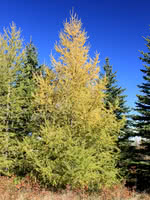Mon-Fri 9am - 5pm Mountain time
Siberian Larch vs Black Locust
Larix sibirica
Robinia pseudoacacia
Siberian Larch is a large, cold hardy conifer. Like the Tamarack, its needles turn golden yellow and drop in the fall, and it is able to handle saturated soils.
If you are looking for a long-lived tree for your large property or shelterbelt with quite wet soil, this is the tree for you.
This variety is often used on the south side of a shelterbelt to let sunlight in during the winter and to provide protection or shading during the summer.
Black Locust is an attractive tree. Its distinctive leaves are made of about a dozen bright green leaflets. It also notable for its fragrant white flowers, which smell of citrus.
Black Locust can grow in many situations, but prefers dry areas with lots of sun. It is robust and is an excellent choice for establishing shade in dry, open areas.
Important note: Much of the Black Locust is toxic to humans and livestock, including seeds, bark, and leaves.

